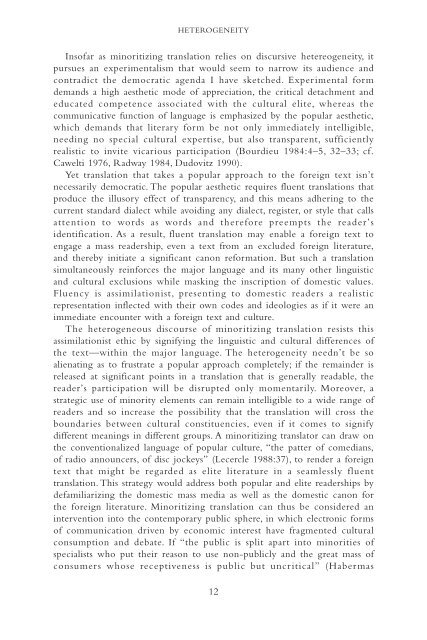THE SCANDALS OF TRANSLATION
9781134740642_sample_893345
9781134740642_sample_893345
Create successful ePaper yourself
Turn your PDF publications into a flip-book with our unique Google optimized e-Paper software.
HETEROGENEITYInsofar as minoritizing translation relies on discursive hetereogeneity, itpursues an experimentalism that would seem to narrow its audience andcontradict the democratic agenda I have sketched. Experimental formdemands a high aesthetic mode of appreciation, the critical detachment andeducated competence associated with the cultural elite, whereas thecommunicative function of language is emphasized by the popular aesthetic,which demands that literary form be not only immediately intelligible,needing no special cultural expertise, but also transparent, sufficientlyrealistic to invite vicarious participation (Bourdieu 1984:4–5, 32–33; cf.Cawelti 1976, Radway 1984, Dudovitz 1990).Yet translation that takes a popular approach to the foreign text isn’tnecessarily democratic. The popular aesthetic requires fluent translations thatproduce the illusory effect of transparency, and this means adhering to thecurrent standard dialect while avoiding any dialect, register, or style that callsattention to words as words and therefore preempts the reader’sidentification. As a result, fluent translation may enable a foreign text toengage a mass readership, even a text from an excluded foreign literature,and thereby initiate a significant canon reformation. But such a translationsimultaneously reinforces the major language and its many other linguisticand cultural exclusions while masking the inscription of domestic values.Fluency is assimilationist, presenting to domestic readers a realisticrepresentation inflected with their own codes and ideologies as if it were animmediate encounter with a foreign text and culture.The heterogeneous discourse of minoritizing translation resists thisassimilationist ethic by signifying the linguistic and cultural differences ofthe text—within the major language. The heterogeneity needn’t be soalienating as to frustrate a popular approach completely; if the remainder isreleased at significant points in a translation that is generally readable, thereader’s participation will be disrupted only momentarily. Moreover, astrategic use of minority elements can remain intelligible to a wide range ofreaders and so increase the possibility that the translation will cross theboundaries between cultural constituencies, even if it comes to signifydifferent meanings in different groups. A minoritizing translator can draw onthe conventionalized language of popular culture, “the patter of comedians,of radio announcers, of disc jockeys” (Lecercle 1988:37), to render a foreigntext that might be regarded as elite literature in a seamlessly fluenttranslation. This strategy would address both popular and elite readerships bydefamiliarizing the domestic mass media as well as the domestic canon forthe foreign literature. Minoritizing translation can thus be considered anintervention into the contemporary public sphere, in which electronic formsof communication driven by economic interest have fragmented culturalconsumption and debate. If “the public is split apart into minorities ofspecialists who put their reason to use non-publicly and the great mass ofconsumers whose receptiveness is public but uncritical” (Habermas12


